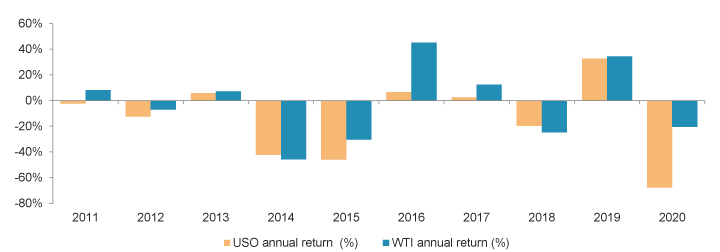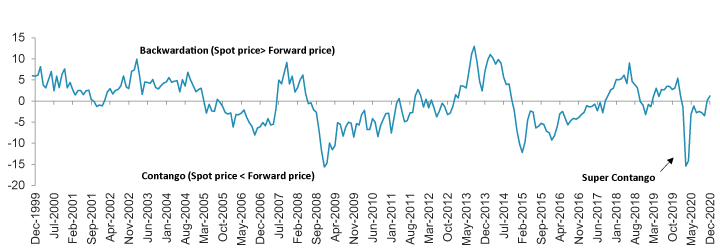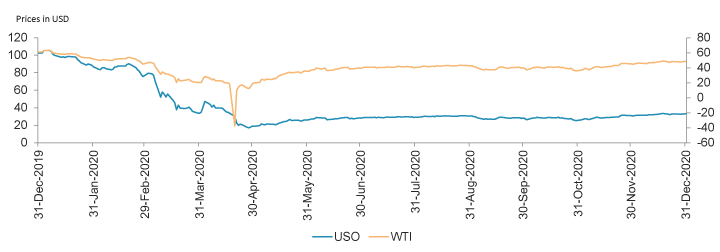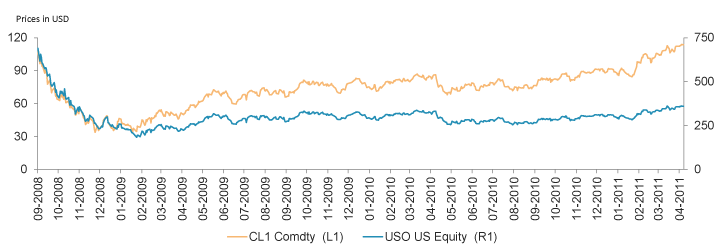US Oil ETFs – A good investment opportunity or a high-risk bet?
Published on 18 Jan, 2021

The recent volatility in crude oil prices has attracted investor interest towards oil ETFs as a proxy to play on the rebound in oil prices. As countries started authorizing emergency approvals, oil prices have shown strong resilience in recovering from the historic lows seen in April 2020. Meanwhile, oil ETFs are still struggling to recover, despite tracking the performance of benchmark oil futures. Does this mean investors betting on ETFs to gain from the anticipation of an oil-price recovery are walking into a trap? Or does the scenario point to something else entirely?
Between January 2020 and April 2020, West Texas Intermediate (WTI) oil spot prices fell drastically from USD61 per barrel to negative USD19 per barrel due to sluggish oil demand caused by COVID-19-led lockdown restrictions and the price war between Saudi Arabia and Russia that resulted in an oversupply situation. However, the easing of lockdown restrictions and a flurry of emergency COVID-19 vaccine approvals indicated an earlier recovery in global oil demand. Thus, WTI oil spot prices recovered to the early March 2020 levels of USD48 per barrel, taking the decline rate in 2020 to 20%. However, some oil exchange-traded funds (ETFs) are still struggling to reflect this recovery in their performance (as can be seen from the following table).
US Oil ETF YTD Returns (%)
Ticker |
ETF Name |
AUM (USDmn) |
2020 Return (%) |
Expense Ratio |
Last NAV per Share (USD) |
|---|---|---|---|---|---|
USO |
United States Oil Fund |
3,685 |
-67.81% |
0.72% |
33.96 |
DBO |
Invesco DB Oil Fund |
446 |
-20.98% |
0.78% |
8.7 |
BNO |
United States Brent Oil Fund |
362 |
-38.52% |
0.90% |
13.36 |
USL |
United States 12 Month Oil Fund |
201 |
-25.28% |
0.79% |
17.66 |
OILK |
ProShares K-1 Free Crude Oil Strategy ETF |
64 |
-61.06% |
0.65% |
44.3 |
OIL |
iPath S&P GSCI Crude Oil Total Return Index ETN |
37 |
-26.99% |
0.85% |
14.53 |
Source: Bloomberg, Note: NAV as of 5th Jan 2021
The listed oil ETFs are structured such that their returns are linked to oil price performance, and yet their features differ. The USO seeks the daily percentage change of its shares’ net asset value (NAV), for any 30 successive valuation days, to be 10% (plus/minus) of the average daily percentage changes in the price of benchmark oil, i.e., WTI futures contracts. The DBO tracks the Deutsche Bank Index Quant (DBIQ), i.e., the Optimum Yield Crude Oil Index Excess Return, which is a rules-based index comprising futures contracts on light sweet crude oil, i.e., WTI. The OIL fund delivers returns through an unleveraged investment in WTI crude oil futures contracts, while the BNO tracks the daily price movements of Brent crude oil. The USL is designed to track the price movements of WTI oil. The OILK seeks to provide total returns through actively managed exposure to the WTI crude oil futures markets. It is not intended to track the performance of WTI crude spot prices.
Despite their investments being exposed to benchmark oil futures, these ETFs have underperformed significantly. The United States Oil Fund LP (USO), one of the largest oil ETFs, shows the highest decline of 68% among the mentioned ETFs, when compared to a decline of 21% in WTI oil spot prices as of 2020-year end. This highlights significant tracking deviation when compared with the returns seen over the past few years. Here we delve deeper to understand the reasons for this deviation using the largest oil ETF – the USO.
USO vs WTI (CL1) Annual Return Performance

Source: Thomson Reuters Eikon
What is the USO ETF?
Managed by United States Commodity Funds LLC, the United States Oil Fund LP (USO) ETF is the largest long-only crude oil ETF in the US; it has about USD 4.0bn worth of assets under management (AUM). As stated in the fund prospectus, the investment objective of USO is “for the daily changes in percentage terms of its shares’ per share net asset value (“NAV”) to reflect the daily changes in percentage terms of the spot price of light, sweet crude oil delivered to Cushing, Oklahoma, as measured by the daily changes in the price of a specified short-term futures contract on light, sweet crude oil called the “Benchmark Oil Futures Contract,” plus interest earned on USO’s collateral holdings, less USO’s expenses”. USO seeks to achieve its investment objective so that the delta between the average daily returns for USO and its benchmark oil (WTI) futures contracts should be within plus/minus 10% over a period of successive 30 valuation days. USO’s net assets consist of investments in oil futures contracts and other oil-related investments that help it gain more liquidity.
How do Contango and Backwardation impact USO ETF’s returns vs. its benchmark oil futures?
Usually, the USO tracks WTI short-term futures well; however, under certain market conditions, the deviations can be more vivid due to the fund’s operating structure. Unlike other ETFs or mutual funds that simply hold stocks or bonds, the USO invests in WTI oil futures contracts. Under these contracts, the USO is obligated to either take physical delivery of the millions of barrels of oili (a single futures contract represents 1,000 barrels of crude) or offset the trade before the expiry date. To avoid this, the USO holds the contracts until two weeks before their expiration previous to selling the old contract and buying another short-term contract. However, rolling over contracts this way when the market is in contango (when the spot price is less than the futures price) effectively means the fund is consistently buying at high prices and selling at low prices, thus losing money on its trades. For example, the USO will be rolling over its position by selling the WTI March 2020 contract brought at 50.3 levels on February 7, 2020 and replacing it with the WTI May 2020 contract brought at 50.8 levels, thus making a loss of USD 0.5 per unit bought. Consequently, even when oil price is rallying well, the USO NAV is underperforming against the spot oil market.
Historically, the crude oil futures market has experienced periods of backwardation and contango, with the latter being more prevalent than backwardation.
Near Month WTI Prices (CL1) minus 1-year forward WTI Prices (CL13)

Source: Bloomberg
Should investors be more cautious after the recent changes in the fund’s investment strategy?
Since the start of 2020, oil markets were already trading in contango due to uncertainty arising from the disputes among oil-producing nations about controlling production. The situation worsened drastically as crude oil prices collapsed due to demand shock attributed to COVID-19 and reduced global petroleum consumption. Lockdown restrictions led to massive drops in industrial, travel, and manufacturing activity, which caused crude oil demand to drop by an estimated 20 million barrels per day; this created an oversupply situation, which pushed oil prices into super contango. This is quite evident from the price differential between spot prices and the 1-year forward prices increasing beyond 15 units as against the less than 5 units level seen over the past 5 years. Such an unprecedented move forced the USO to change its investment strategy by shifting from short-term contracts to long-term ones. As seen from the following table, the USO shifted its concentrated target portfolio composition in short-term futures (contracts set to expire in June 2020) during April 2020 to a more diversified composition spread over later expiry future contracts up to June 2021; the same pattern is followed in the current December 2020 portfolio mix.
USO’S Target Share of Portfolio Invested in WTI Futures
Expiry month |
Jun-20 |
Jul-20 |
Aug-20 |
Sep-20 |
Oct-20 |
Dec-20 |
Jun-21 |
|---|---|---|---|---|---|---|---|
16-Apr-20 |
80% |
20% |
|||||
21-Apr-20 |
40% |
55% |
5% |
||||
22-Apr-20 |
20% |
50% |
20% |
10% |
|||
24-Apr-20 |
20% |
40% |
20% |
20% |
|||
27-Apr-20 |
30% |
15% |
15% |
15% |
15% |
15% |
|
Expiry month |
Mar-21 |
Apr-21 |
May-21 |
Jun-21 |
Jul-21 |
Aug-21 |
Dec-21 |
5-Jan-21 |
20% |
20% |
15% |
15% |
10% |
5% |
15% |
Source: USO’s Form 8-K Disclosures
As lockdown restrictions ease, economic activity has improved gradually. Coupled with growing hopes of fast-track vaccine approvals, this has helped short-term oil prices bounce back to USD49 per barrel levels seen by end of 2020. However, USO NAV recovered at a comparatively slower rate to USD33 per share, mainly due to its changed investment strategy. Typically, prices in longer term oil contracts are less volatile than those in shorter term ones; hence, even the sharp rally in global prices resulted in a comparatively small move in USO’s NAV. Furthermore, the rollover cost of diversification into long-term contracts negatively affected the fund’s performance. Therefore, USO NAV recovered by only 73% since the changes were announced as against a 158% surge in WTI oil spot prices.
US (LHS) vs WTI CL1 (RHS)

Source: Thomson Reuters Eikon
What should investors learn from the past?
The current scenario is easily comparable to the global financial crisis (GFC) that started in the fourth quarter of 2008. Unusually high inventories of crude oil due to sluggish US and global demand, and issues related to the storage and physical transportation of crude oil at Cushing, Oklahoma have created an oversupply situation. As a result, the global crude oil market went into contango and remained there for a good while. As transportation issues were resolved and global demand recovered, the inventory build-up moderated and thus reduced levels of contango by April 2011. Consequently, oil prices recovered completely to the pre-crisis levels, but the USO’s NAV remained lower by 48% over the same period. There is a possibility of a similar impact of contango on the USO’s NAV now, making it riskier to play on the rebound in oil prices as economic activity returns to pre-COVID-19 levels.
USO (RHS) vs WTI CL1 (LHS) Performance Post GFC

Source: Bloomberg
Conclusion
As in the past when the crude oil futures market was in contango, the USO’s returns would tend to be on the lower side as the portfolio was invested completely in near-month crude oil futures contracts. Conversely, the USO’s current investment strategy to diversify the portfolio containing 12 months of crude oil futures may generate higher returns, provided the oil markets remain in contango. However, the easing of lockdown restrictions and faster vaccine approvals are raising hopes of a much quicker economic recovery than anticipated. Thus, oil markets might turn into backwardation, which would negatively affect the USO’s NAV due to the recent change in its investment strategy. Hence, investors should tread cautiously. What holds true for the USO would also ring true for most of the other oil ETFs, warranting caution from investors seeking to take advantage of the current oil price recovery.

